Working in Interesting
Locations:
Photographing Models in a Fire Truck Factory
by Joe Farace
I am always on the lookout for interesting
locations to make glamour images, so when I had the chance to photograph gorgeous models at a fire truck
factory for a calendar, how could
I say no?
Shooting in any kind of factory presents lots of challenges. Obviously,
there are lighting problems with fifty-foot high ceilings and mixed light
sources. There were also environmental challenges for the me and models
when shooting in the winter inside a hangar -like structure that's heated
with the type of radiant heat that keeps the trucks comfy but not
necessarily the people working inside-especially when they're wearing next
to nothing!
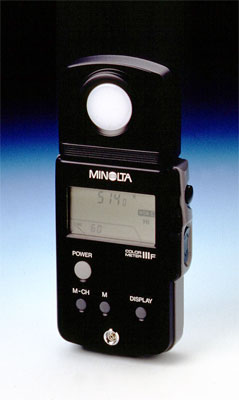 When
shooting digital images and working under weird lighting conditions, the
typical and the most obvious solution is to create a custom white balance
setting using the flip side of a Kodak Gray Card. (It's white in case you
never noticed.) The problem I encountered almost immediately at the fire
truck factory was that the color balance varied within a few feet of
anyplace I shot. Just when I thought the camera's white balance was
perfect, I'd take a few steps to the left and the color would look sickly.
My initial solution was to play with all of the camera's built-in color
balance settings and find one that worked until I finally found that using
Auto White Balance, which all the digital gurus will tell you NEVER to
use, worked best. Since the Canon EOS 10D and other digital SLRs, like
Olympus' E-1, let you set the specific color balance in degrees Kelvin I
used a Minolta Color Meter IIIF at my last shoot. I was able to get almost
perfect color balance by reading the color temperature and changing the
camera's White Balance settings each time I changed locations within the
factory. When
shooting digital images and working under weird lighting conditions, the
typical and the most obvious solution is to create a custom white balance
setting using the flip side of a Kodak Gray Card. (It's white in case you
never noticed.) The problem I encountered almost immediately at the fire
truck factory was that the color balance varied within a few feet of
anyplace I shot. Just when I thought the camera's white balance was
perfect, I'd take a few steps to the left and the color would look sickly.
My initial solution was to play with all of the camera's built-in color
balance settings and find one that worked until I finally found that using
Auto White Balance, which all the digital gurus will tell you NEVER to
use, worked best. Since the Canon EOS 10D and other digital SLRs, like
Olympus' E-1, let you set the specific color balance in degrees Kelvin I
used a Minolta Color Meter IIIF at my last shoot. I was able to get almost
perfect color balance by reading the color temperature and changing the
camera's White Balance settings each time I changed locations within the
factory.
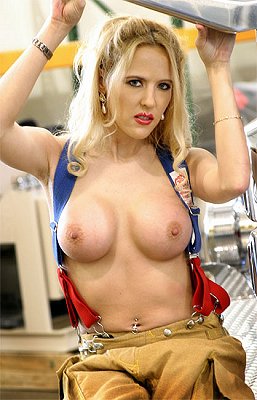 |
This photograph of Kyla
Young was made with her wearing part of the "bunker"
protective clothing used by real firefighters.
The image was made with a Canon EOS
10D set at ISO 800 and the White Balance set on "Auto."
The lens was a 28-105mm f/2.8 lens at 105mm with a shutter speed
of 1/20th of a second at f/4.5.
No camera support was used and no
color balance tweaking was done in Adobe Photoshop CS to get the
results you see here.
(Kyla Young appears courtesy of Vapor
Industries) |
Photography is all about lighting so I initially tried using available
light--every monolight I had available--but the results were less than
impressive. Not only were there the inevitable color balance issues, but
color reflections became more a problem. Remember kiddies, we are dealing
with really large vehicles painted bright red, international orange,
signal yellow, and blessedly and thankfully the occasional (although not
enough of them) white. So color pollution is a challenge that retouching
can't always solve. After four different photo sessions at the factory I
have come to believe that using available light is the most cost effective
way to shoot there, although I sometimes add fill flash using an on-camera
Canon ETTL flash unit, such as the 420EX. This approach to lighting is not
necessarily the best, but from the client's point of view it's the most
affordable way to deliver the quantity and quality of images he can
afford.
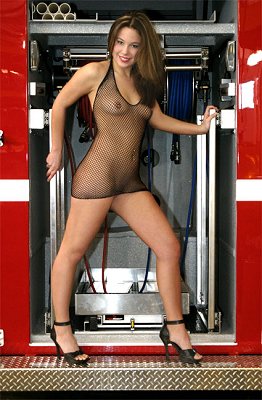 |
This image of the
wonderful model Leslie was made with a Canon EOS 10D set at ISO
800 and the White Balance set on "Auto."
The lens was a 28-105mm f/2.8 lens
set at 45mm with a shutter speed of 1/60th of a second at
f/4.0.
No color tweaking was done to this
image file to get these results.
A Canon 420EX with Sto-fen
diffuser attached to the head, which I consider an indispensable
accessory, was used as fill because of Leslie's placement inside
the rear doorway of the truck. |
Let's get to the question that's in the back of your head right now.
All shots at the factory are made when there are no workers present and
with the full permission of the company's owners, and while one or both of
them may be in the factory at the time of the shoots, they did not hang
around gawking. OK, buckaroos? Safety is the most important aspect of any
on-location shoot, such as the one with Leslie standing on the bumper of a
fire truck. An experienced firefighter is always "on set" both
as liaison with the factory and also to act as safety advisor to make sure
the models are completely safe in any of the poses or situations in which
they are placed. For example, this bumper was thoroughly cleaned to make
sure there were no metal shavings or bits and pieces before Leslie stood
on it, and a veteran firefighter was just out of camera range to come to
her assistance if needed.
OK, by now you've noticed that both of the previous images have been
made at ISO 800. Yuck, you must be saying, what about noise? Yeah, what
about noise? The real question here is two fold: How much noise can you
tolerate? And how much noise does your camera produce at high ISO
settings.
Waddaymean you never tried?
Don't make any generalizations. Test your own camera. The Leica Digilux
1 I shot at an indoor car show had horrible noise at ISO 400 and under low
light conditions the Canon SD10 produces noticeable noise at ISO 200 and
too much at ISO 400, but the EOS 10D produces hardly more noticeable noise
at ISO 800 than it does at ISO 400. In fact, it looks better, because the
quality of the noise changes with exposure. And more exposure seems to
soften the noise.
|
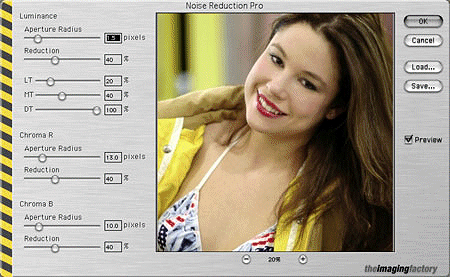
|
| In past columns I've
talked about noise reduction software but my favorite remains Noise
Reduction Pro. It was used on the photograph of Leslie, but
not for Kyla's image since I have noticed that how obnoxious the
noise is depends on the image's overall brightness. Most of the
time, I apply the Noise Reduction Pro Photoshop compatible plug-in
at its default settings and am pleased with the results.
The Imaging Factory also offers a
$39.95 Noise Reduction plug-in, compared to the $99.95 pro
version, and you can download them both for a 30-day trial and
test both plug-ins on your noisiest images to see which one you
like best. |
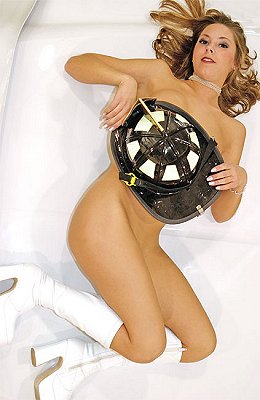 |
'Splain this to me,
Lucy...
This shot was originally made using
a custom white balance while photographing Megan, who was Miss
September for the past two calendars.
She's lying on the hood of a white
emergency vehicle and is the only one in this story I had to color
correct.
This image was made with a Canon
EOS 10D set at ISO 400 with a 28-105mm f/2.8 lens set at 45mm with
a shutter speed of 1/60th of a second at f/4.0. A Canon 420Ex was
used for fill.
I was perched on a 30-foot high
rolling platform (another advantage of working in a factory)
shooting down on Megan lying on the hood of a tall vehicle wearing
only her boots and hat. |
| Joe
Farace is Colorado-based photographer/writer who has written
or edited 24 books, many of which are is available through www.joefarace.com.
But it's not all glamour. Be sure to visit www.joefaraceshootscars.com
to see Joe's automotive work. |
 Subscribe to
Vivid Light
Subscribe to
Vivid Light
Photography by email
Tell
Us What You Think
Text & photographs
©2004 Joe Farace
|

|
